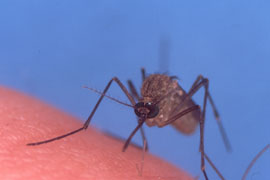Cronkite News has moved to a new home at cronkitenews.azpbs.org. Use this site to search archives from 2011 to May 2015. You can search the new site for current stories.
West Nile cases in U.S. rising, but Arizona remains steady
PHOENIX – While West Nile virus is a skyrocketing problem around the country, cases in Arizona are on par with previous years.
Thirty-seven cases, one of them fatal, had been reported to county health departments across Arizona through Aug. 30, 25 of which have been reported to the state health department.
“So far, our cases have been tracking right about usual for where we are for the season,” said Shoana Anderson, office chief for the Arizona Department of Health Service’s Office of Infectious Diseases.
It’s a far different story in other parts of the country. The Centers for Disease Control and Prevention reported 1,590 cases – 66 of them fatal – through Aug. 28., putting the U.S. on track for the worst year ever.
West Nile, which is transmitted through mosquito bites, was first found in Arizona in 2003. The virus usually doesn’t usually cause severe symptoms in infected persons, but in rare cases it can lead to meningitis and encephalitis.
Most of those infected with West Nile have few or no symptoms. Only one in five will experience headache, fever, nausea, aches and other mild symptoms.
Older people and those with compromised immune systems are greatest risk of developing severe symptoms.
Most Arizona infections have been in Maricopa County, which reported 34 cases this year as of Aug. 30.
Officials said they are unsure why Arizona has been affected less severely than other parts of the country.
“We don’t really know why it takes hold in some places more than others,” Anderson said. “It could be that we are doing better mosquito control.”
Mosquitoes breed rapidly around bodies of still water. Large puddles or abandoned pools in foreclosed homes can be prime areas for the insects to multiply, thus increasing their chances of spreading the disease.
Counties lead the effort to eradicate mosquitoes carrying the disease by testing populations and fogging infected areas.
Michael Acoba, epidemiology program manager for Pima County Health Department, which had its first probable case of the year reported in late August, said the mosquito population is about the same as previous years.
He said Pima County’s public awareness campaigns might have contributed to a milder West Nile season than elsewhere.
“We are hoping it’s because people have heard our message over the years and they are taking the precautions,” he said.
Not all types of mosquitoes carry West Nile. Populations that can transmit the virus tend to be most active between dawn and dusk.
“We really encourage people to fight the bite and try to prevent being bitten by mosquitoes,” Anderson said. “If you can avoid getting mosquito bites you are going to avoid the infection.”
Heather Murphy, director of communication and public affairs for Pinal County, which has had two cases of West Nile this year, said that people who have been bitten shouldn’t panic.
“If you have no symptoms that are unusual, it’s probably not worth running to the doctor for unless it’s serious and more severe,” she said.









